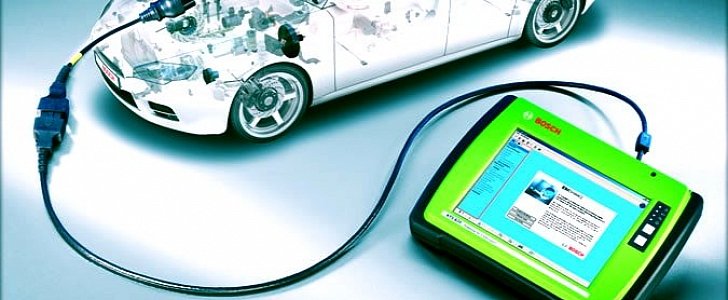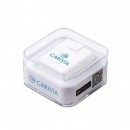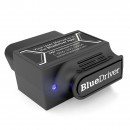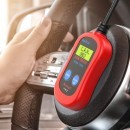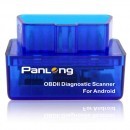For some time now, vehicles sold across the world have had the ability to self diagnose their problems. This capacity is referred to in the industry as on-board diagnostics, or OBD.
On-board computers with scanning capability have been around since the late 1960s, having been introduced by Volkswagen, and then quickly adopted by the industry. It was not until 1988 though that the Society of Automotive Engineers (SAE) recommended the creation of a standardized diagnostic connector and set of diagnostic test signals.
Present-day OBD is in fact a set of tools, codes, and procedures that allows the vehicle to determine if and what is wrong with itself, and then relay that information to humans whenever asked to. The OBD issue so-called diagnostic trouble codes (DTCs) when queried, and almost all DTCs have a fix available in a vast online library.
As cars have grown increasingly complex, so did the number of errors they encounter. All those warning signs that pop up on modern-day car’s dashboards are signs that the computer thinks something is wrong. These lights are the means used by the vehicle to alert driver they should take the car in for a checkup. Once in service, the car is diagnosed using a computer and its available OBD port.
For a while now, various electronics manufacturers have begun offering OBD tools to everyone willing to buy them. Mostly available online, these devices allow owners to learn about errors even before going into a service, and the few skilled ones among us can even try and fix the issue themselves.
There are several types of OBD interfaces, depending on the make and year of the car. The oldest is the Assembly Line Diagnostic Link (Assembly Line Diagnostic Link) introduced by GM in the 1970s, and the latest ODB II (EOBD in Europe).
Below is a list of five diagnostics gadgets available on Amazon that can be used by almost anyone and on nearly all cars.
Be warned. Using a vehicle diagnostic tool bought online does not make you a mechanic any more than surfing medical website makes you a doctor. Make sure you know what you are doing if you decide to fix whatever problem you find on your own.
BlueDriver LSB2 (ad) - The BlueDriver is comprised of the actual sensor that connects to the OBD port and a mobile app that acts as an interface. The app is compatible with both Apple and Android devices.
Once plugged-in, the sensor reads, identifies and if needed clears warnings and alerts. To do this, it uses a database called Identifix, one of the largest currently available. Once the error red, the system comes up with a complete repair solution taken from the database of 30 million fixes.
Aside from identifying problems and recommending fixes, the BlueDriver can be used to determine if the car is ready for an emissions test, provides the full vehicle specifications and maintenance schedule, alert drivers of announced recalls and even displays issued technical service bulletins.
The BlueDriver is compatible with most cars manufactured by the American Big Three, but also with those of Toyota, Nissan, Honda, Volkswagen and Mazda.
On Amazon, the BlueDriver sells for $99,95.
BAFX (ad) - The BAFX is an OBD device that only works with Android or Windows devices. According to its manufacturer, it is compatible with all vehicles purchased in the U.S., including foreign ones, provided they are manufactured after the year 1996.
The system can be used to identify why the check engine light is on and clear it, but it will not give you any info on why lights for the ABS, SRS, TPMS, or Oil Change are on. The BAFX can provide info on emission levels before a crucial test and also provides data on the air/fuel ratio.
The system works with the help of an app, but there’s not a specific one you can use. The producer recommends though Torque Pro.
On Amazon, the BAFX diagnostic tool sells for $22,89.
Autel MS300 (ad) - A more professional looking tool is the Autel MS300, a purpose-built OBD reader that needs no smartphone app to run. All the info it detects is displayed on a backlit LCD screen, and it can be controlled using only two dedicated buttons.
The system can read, clear, and come up with solutions for DTCs based on a catalog of around 7,000 items. That includes clearing the check engine light and providing info on emissions test readiness. As a bonus, the Autel can read the cars VIN, if you can find a use for it.
Autel can be used on most cars sold in the U.S. after 1996, is multilingual and sells on Amazon from $19,99.
Panlong (ad) - The Panlog device is for some reason meant only for gasoline cars - manufactured after the year 1996 - and it only works on Android devices. For that to happen, one needs to download a third-party app, preferably one recommended by the manufacturer: Torque Pro, Torque Lite or OBD Car Doctor.
Just like the previous systems, it too can be used to identify and clear warning lights, but also provides fixes for an (unknown) number of problems. Additionally and with the help of the said apps, Panlog keeps track and shows vehicle speed, throttle position, engine rpm, fuel consumption, air flow rate and more.
On Amazon, this OBD device sells for just $10.98.
Carista (ad) - Carista is perhaps the most pretentious entry in our list, as it promises the power of dealer-level technology at your fingertips. And we have reason to trust that, as most of its features are offered for extra bucks.
The Carista works of both iOS and Android devices through its own dedicated app. As standard, it only offers the possibility of identifying the reason why the check engine light is on, provides a list of codes for the errors and the steps that need to be taken to reset it.
A paid feature, however, is where all the fun begins. The Carista opens up like a flower and spills all it knows on electronics, ABS, airbags and pretty much all other manufacturer-specific systems.
This feature – which is offered for free for a month when purchasing the device – only works on certain cars manufactured by Volkswagen, Nissan, Audi, BMW, Infiniti, Lexus, MINI, Scion, and Toyota.
The Carista device sells on Amazon for $19,99, and all its functionalities can be unlocked after paying $40/year.
Present-day OBD is in fact a set of tools, codes, and procedures that allows the vehicle to determine if and what is wrong with itself, and then relay that information to humans whenever asked to. The OBD issue so-called diagnostic trouble codes (DTCs) when queried, and almost all DTCs have a fix available in a vast online library.
As cars have grown increasingly complex, so did the number of errors they encounter. All those warning signs that pop up on modern-day car’s dashboards are signs that the computer thinks something is wrong. These lights are the means used by the vehicle to alert driver they should take the car in for a checkup. Once in service, the car is diagnosed using a computer and its available OBD port.
For a while now, various electronics manufacturers have begun offering OBD tools to everyone willing to buy them. Mostly available online, these devices allow owners to learn about errors even before going into a service, and the few skilled ones among us can even try and fix the issue themselves.
There are several types of OBD interfaces, depending on the make and year of the car. The oldest is the Assembly Line Diagnostic Link (Assembly Line Diagnostic Link) introduced by GM in the 1970s, and the latest ODB II (EOBD in Europe).
Below is a list of five diagnostics gadgets available on Amazon that can be used by almost anyone and on nearly all cars.
Be warned. Using a vehicle diagnostic tool bought online does not make you a mechanic any more than surfing medical website makes you a doctor. Make sure you know what you are doing if you decide to fix whatever problem you find on your own.
BlueDriver LSB2 (ad) - The BlueDriver is comprised of the actual sensor that connects to the OBD port and a mobile app that acts as an interface. The app is compatible with both Apple and Android devices.
Aside from identifying problems and recommending fixes, the BlueDriver can be used to determine if the car is ready for an emissions test, provides the full vehicle specifications and maintenance schedule, alert drivers of announced recalls and even displays issued technical service bulletins.
The BlueDriver is compatible with most cars manufactured by the American Big Three, but also with those of Toyota, Nissan, Honda, Volkswagen and Mazda.
On Amazon, the BlueDriver sells for $99,95.
BAFX (ad) - The BAFX is an OBD device that only works with Android or Windows devices. According to its manufacturer, it is compatible with all vehicles purchased in the U.S., including foreign ones, provided they are manufactured after the year 1996.
The system can be used to identify why the check engine light is on and clear it, but it will not give you any info on why lights for the ABS, SRS, TPMS, or Oil Change are on. The BAFX can provide info on emission levels before a crucial test and also provides data on the air/fuel ratio.
The system works with the help of an app, but there’s not a specific one you can use. The producer recommends though Torque Pro.
On Amazon, the BAFX diagnostic tool sells for $22,89.
Autel MS300 (ad) - A more professional looking tool is the Autel MS300, a purpose-built OBD reader that needs no smartphone app to run. All the info it detects is displayed on a backlit LCD screen, and it can be controlled using only two dedicated buttons.
Autel can be used on most cars sold in the U.S. after 1996, is multilingual and sells on Amazon from $19,99.
Panlong (ad) - The Panlog device is for some reason meant only for gasoline cars - manufactured after the year 1996 - and it only works on Android devices. For that to happen, one needs to download a third-party app, preferably one recommended by the manufacturer: Torque Pro, Torque Lite or OBD Car Doctor.
Just like the previous systems, it too can be used to identify and clear warning lights, but also provides fixes for an (unknown) number of problems. Additionally and with the help of the said apps, Panlog keeps track and shows vehicle speed, throttle position, engine rpm, fuel consumption, air flow rate and more.
On Amazon, this OBD device sells for just $10.98.
Carista (ad) - Carista is perhaps the most pretentious entry in our list, as it promises the power of dealer-level technology at your fingertips. And we have reason to trust that, as most of its features are offered for extra bucks.
The Carista works of both iOS and Android devices through its own dedicated app. As standard, it only offers the possibility of identifying the reason why the check engine light is on, provides a list of codes for the errors and the steps that need to be taken to reset it.
A paid feature, however, is where all the fun begins. The Carista opens up like a flower and spills all it knows on electronics, ABS, airbags and pretty much all other manufacturer-specific systems.
This feature – which is offered for free for a month when purchasing the device – only works on certain cars manufactured by Volkswagen, Nissan, Audi, BMW, Infiniti, Lexus, MINI, Scion, and Toyota.
The Carista device sells on Amazon for $19,99, and all its functionalities can be unlocked after paying $40/year.
